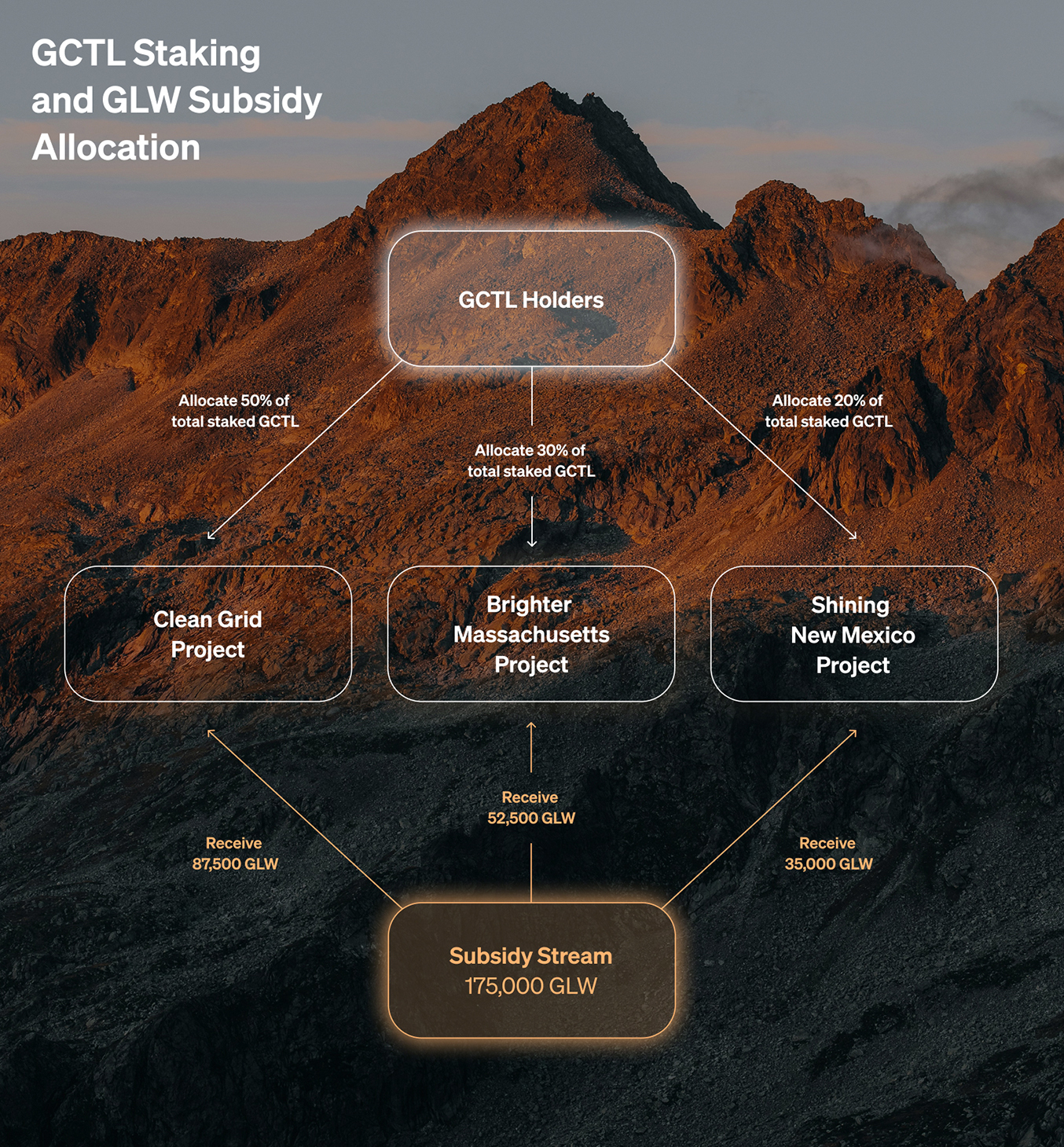Glow was created to be a platform that brings positive change to the world. Even more than that, Glow empowers individuals to change the world according to their own vision for a brighter future.
Capitalists and Visionaries
Glow views people through two different lenses. There are the capitalists, who optimize their actions to maximize profits, and there are the visionaries, who use incentives to steer the capitalists towards their own goals. Each person is playing a different type of game: the capitalists are happy as long as they are making more money than everyone else, and the visionaries are happy as long as they are making the world a better place.
If capitalists and visionaries are the players, then Infrastructure Projects are the arena. An Infrastructure Project is a tool within the Glow ecosystem that enables visionaries to control what makes the most money for capitalists.
A Simple Example: Carbon Credits
The very first Infrastructure Project on Glow was the Clean Grid Project. This project awarded 175,000 GLW tokens per week to solar farms that optimized for reducing global emissions over raw electricity profit. Capitalists who were better at constructing impactful solar got more tokens.
The results speak for themselves. Within 12 months, Glow went from building solar in Utah, to building solar in Colorado, to building solar in India. Each step moved deeper into the territory of real-world impact, and by the end Glow had offset the annual emissions of more than 100,000 people, powered by more than $18 million worth of solar.
Perhaps even more interesting than the sheer scale of the project is the efficiency. Glow didn't just build $18 million of solar, it built $18 million of solar in India, allowing Glow to have as much carbon impact as $30 million of solar in the United States. Glow's visionaries had set up a simple game where the most profitable activity for capitalists was to produce as many carbon credits as possible, and the capitalists were happy to oblige.
Generalizing Impact with Infrastructure Projects
Just as Glow can be used to create carbon credits on the global stage, Glow can be used to drive other types of impact as well.
For example, building solar has many benefits beyond just reducing the amount of carbon dioxide in the atmosphere. It reduces many types of air pollution, which is beneficial for the health of the people living nearby. It is estimated that over their lifetime, the $18 million of solar in India will prevent more than 10,000 Indian asthma attacks, and will even reduce the number of Indian miscarriages.
And while most visionaries are happy to see that Glow is improving the lives of everyday people in India, they also want to extend those benefits to their own countries. All by itself, the Clean Grid Project doesn't offer that flexibility, but there are many potential Infrastructure Projects, and visionaries can accomplish their own goals by setting up something new.
The goal that the Clean Grid Project presents to capitalists is "Produce as many carbon credits as possible by building solar anywhere in the world." A trivial modification of this would be "Produce as many carbon credits as possible by building solar anywhere in Mexico." But visionaries could even go a step further, and set up a rule like "Reduce as many asthma attacks as possible by building solar anywhere in Mexico."
In truth, visionaries can set almost any goal for their Infrastructure Project. As long as the Infrastructure Project has tokens and the incentives within the project are effective at motivating capitalists, then Infrastructure Projects are an almost unconstrained medium by which visionaries can change the world.
The Anatomy of an Infrastructure Project
To translate these visions for society into real-world outcomes, each Infrastructure Project defines:
- What is being built, such as solar farms, battery systems, or other energy assets.
- Where it is being built, defined by jurisdiction, grid region, or other clear geographic scope
- How performance is measured, whether by total carbon displacement, grid uptime and stability, air quality, or another verifiable metric.
These criteria are combined to create an arena where capitalists can earn tokens by increasingly efficient ways to achieve the ‘How’ of the Infrastructure Project. As the project scales up, the competition becomes more optimized, and every dollar of incentive is stretched to have an increasingly significant impact.
Funding Infrastructure Projects with GCTL
Perhaps the most challenging aspect of changing the world is finding funding. As much as people want to help each other, nobody wants to spend their own hard-earned money. Glow solves this problem by creating an evergreen fountain of tokens - 175,000 GLW tokens per week - that can be distributed to Infrastructure Projects to power impact. Visionaries determine how many GLW tokens go to each Infrastructure Project by staking an asset called Glow Control, or GCTL.
Once a visionary owns GCTL, they own the ability to steer GLW tokens towards their own Infrastructure Projects for the rest of their lives. And the more GCTL they own, the more GLW tokens they steer. Figure 1 below provides an example that shows how GCTL staking directs the protocol’s GLW subsidy stream across multiple projects. This design is described in greater detail in the article on Glow Control.

Figure 1: Hypothetical GCTL Staking and Subsidy Allocation
Once GLW rewards start flowing, they power the system described in our article on the Competitive Recursive Protocol, an engine that aligns capitalists with the what, where, and how of the Infrastructure Project.
Delivering Results at Scale
Glow’s Competitive Recursive Protocol depends on attracting enough capitalists to establish a meaningful competition. As more capitalists enter the market, the competition intensifies, and the Infrastructure Project gets more efficient at delivering outsized impact. Once the flywheel is spinning, it tends to optimize all by itself, however, enough incentive must be provided to kick-start the project.
Each Infrastructure Project on Glow establishes resources and strategies that other Infrastructure Projects can leverage. This means that the Infrastructure Projects which are most similar to existing Infrastructure Projects require the least amount of staked GCTL to successfully get going. It also means that projects that are more constrained or more unique will require more GCTL to start successfully.
The first Infrastructure Project, the Clean Grid Project, used the Competitive Recursive Protocol to construct solar in Utah, Colorado, and India. This means that new infrastructure constrained to these regions or even nearby regions would be a natural follow-up and would only require a small amount of staked GCTL. Projects focused on further away regions, or with more novel ‘how’ conditions, such as “optimize for reducing asthma attacks,” would require more GCTL, and moving away from solar entirely would potentially require comparatively large amounts of staked GCTL.
Anyone can propose a new Infrastructure Project through Glow governance. This proposal will undergo review by Glow’s auditors, advisors, and the GLW token holders. If the governance body believes that the Infrastructure Project is sufficiently aligned with Glow’s objectives and has sufficient staked GCTL to be successful, then the Infrastructure Project will launch. For well-established ideas such as regional clones of the Clean Grid Project, the process can be streamlined.
Sculpting Humanity’s Future

Infrastructure Projects empower visionaries to bend reality towards their own version of a better future. They define what gets built, where it happens, and the measures of success, and they do so at a scale that meaningfully changes the shape of the world. With enough GCTL, any visionary can rewire economies and fund the infrastructure that they want to see in the world. The introduction of Glow changes the future of the world from one that is chaotically shaped by the whims of Capitalism to one where Capitalism itself is held accountable to the visions of the people.
